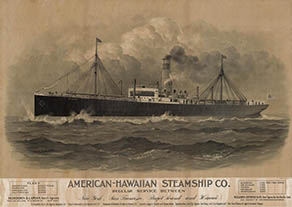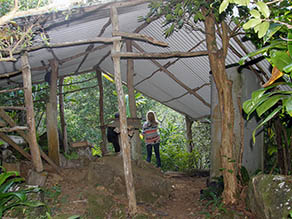 |
 |
 |
 |
||||||
|
|
|
|
|
|
|
|
|
|
| People | Environment | Invasives | Food Today | Sovereignty | Language | Sources & Links | |||||||||
 |
The forest of invasive species adjacent to the lo‘i. |
 |
|||||||
 |
“Why do we have these invasives?” Carlos asks. “Because people brought the invasives—they didn’t come in and spring up by themselves, they were brought. This is a forest of invasive species all around us”—he points to the trees surrounding the lo‘i area on the coastal plain, “except for about an acre or an acre and a half where we’ve cleared the forest and brought the water back in—using it to plant the taro, which is our elder sibling.” “Landscaping brought in a lot of invasive species,” Kawika explains, “and a lot of them were brought in by well-meaning foresters in the 1800s. A lot of people don’t realize this about Hawai‘i’s forestry history, but if you look at all the old photos in the late 1800s or early 1900s, you don’t see any trees on the landscape. And people have often interpreted it like ‘Oh yeah, the Hawaiians cut down all the forest, that’s why there’s no trees.’ “But we now that what happened is that in the 1800s, the steamships were going in-between the islands, and between here and California, and here and Asia, and they needed fuel. There were wharfs all over the place. The closest one here was a wharf in Waihiha. All over Hawaiʻi people would cut down wood and sell it to the steamships for fuel. Up to the 1800s, there was forest all over the place. “And then whenever you cut down trees, grasses come up. That’s the just nature of what happens when you cut down a forest. And then that opens up cattle ranching. So for those guys, they’re getting money on both ends: getting money for cutting down the forest, and then turning it into the pasture land and they get more money for the cows. But I think it was originally driven by the need for fuel on the front end, and the back end was driven by the cattle industry. “So all of the forests were decimated and the streams started drying up, and the Sugar Planter Association was like, ‘Where’s the water for our sugar cane, wet side of the island?’ So in 1917 or 1918, they sent out this guy Dr. Lyon, who is the namesake of Lyon Arboretum on O‘ahu, and he traveled around the world. His goal was to find the fastest growing, most useless trees so that they could reforest Hawai‘i—and nobody would ever want to cut them down because they’re not good for fuel, they’re not good for carving. 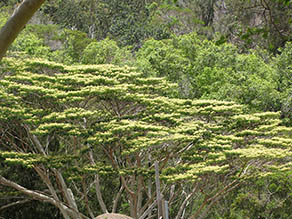
“And so he brought in the worst trees—the albizia and the banyans. You couldn’t do anything with that wood, it’s really junk and they grow super-fast, they take over. So he was super successful, but that was the prevailing wisdom of the time—that that was the best thing to do. But it ended up, in retrospect, being one of the worst things they could have done.” “A lot of the invasive trees and plants that come in here completely alter the forest structure and system such that the native plants can’t really survive. Other invasive trees come from highly competitive ecosystems, like the Amazon or South East Asia, Australia. Those are ecosystems where you really have to fight to survive. Those are competition-based systems. “The Hawaiian civilization, both ecologically and socio-culturally, was very cooperative. Everything was kind of built to support each other. So when the Polynesians originally came in, they’re working with the system that naturally cooperates with itself. But if you’re going to fit into that system, you need to do so cooperatively. We have cooperative system built on a cooperative system. 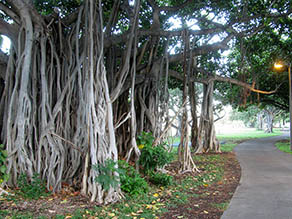
“But then that was all supplanted—both ecologically and culturally—by competitive systems. So there are trees that have come in and have out-competed the natives in the forests. They out compete for various resources like sunlight, and make a really dense canopy and shade out everything under it; or they’ll out compete for water, so they’ll suck right out of that and put it in its body so it’s not available for other plants. Or it will poison the soils biochemically in ways that will kill plants other than its own species. “And then it changes the whole dynamic of the system, and its no longer a habitat for the birds or habitat for our culture, and we end up in a forest that we can’t tell stories in. We don’t have uses for the plants there, and it just makes a disconnect between the community and the forest more permanent. “Ironwood is from Australia. And then Schefflera is from Australia too. The one that’s taking over the cliffs right now is the Autograph Tree. ‘Autograph’ because you can write your name in the leaf. It’s similar to a banyan, it’s a strangler tree, it sends down these long runners. But it’s from a completely different family. And it makes these very dense canopies. 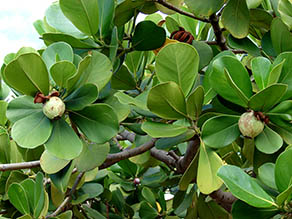
“That’s the tree attempting to strangle the mountain. That’s what it does. It has little seeds. A bird poops out the seed on the crotch of a tree and they’ll grow and then send down its roots and strangle the tree and then take its place in the canopy and put out all of these long lateral branches that are very dense. It takes up all the light, very dense canopy and then it drops this leaf litter. These leaves just take forever to decompose and make those very dense leaf litter so nothing else can come up through it. It’s from the edges of the Amazon.” “The Autograph tree is another one that grows epiphytically,” Merlin adds. “It’s taking over even the Schefflera. You can see it on this rocky out cropping over here on the slope of Makana—that’s almost all autograph. And they get bigger and are even more aggressive than Schefflera, and they extend their roots down hundreds and hundreds of feet, and if you walk a little bit you can actually see the roots and it looks like all of those ropes there, they just send their roots down and suck up all the water. They are extremely aggressive invasives. “We’re trying to keep it somewhat controlled. When the Autograph starts getting up on the top of Makana, we’re going to have to go up there and start removing them. Steve Pearlman, a pretty famous field botanist that worked with NTBG for 35 years, makes it one of his projects to go up on the top of Makana and cut down the invasive trees that are up there, so it doesn’t change the profile of the mountain. 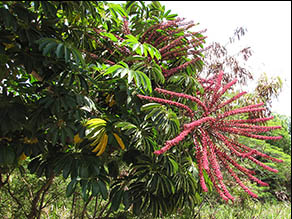
“The Octopus tree is really moving in. In Limahuli, I have never seen an infestation like this anywhere I’ve been in the state. I think it’s the water and the rockiness, and it grows epiphytically so it sprouts up in the crotches of trees, on mossy rocks. It just gets a foothold wherever it can. That’s all these white trunks you can see in the hills and the valley. “Supposedly the 70’s when Limahuli was first getting opened up to the public—or getting worked on as a botanical garden—this tree wasn’t even here at all. There was maybe one or two of them. So this just happened in 30-35 years, and now there are probably a couple million—at least—in the whole valley. But the higher up you go, there are still pockets of some really nice native forest. "This one is clidemia. That’s the worst. It’s the same family as miconia: Melastomataceae. Clidemia, each fruit contains hundreds of seeds. They continuously flower and fruit from about two feet tall. They start flowering and fruiting, and they flower and fruit all year long. They’re kind of sweet little purple berries, so the forest birds eat them and spread them all over the place in their poop. This has only been on Kaua‘i since maybe the 70’s. I would say it’s covering probably 70% of the island now. It’s an invasive plant that we don’t control. 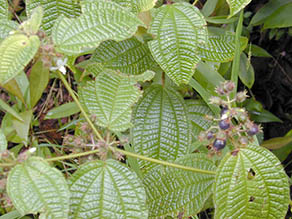
“It’s interesting when you’re doing invasive weed control, because you have your target species, and you’re walking past all these other species that are highly invasive, but you’ve got to pick the battles that you can maybe, well, not win but have some effect with it. But Clidemia is not one of those. They are working on a bunch of bio-controls for it. It’s another one that’s from tropical America, so there are some fungal pathogens that were released. We’re working on ways to control it. “This project we’re doing, called the Remnant Forest Project, we are surveying the valley looking for rare plants—looking for nice patches of diverse native forests—and then we come in and we remove the Schefflera—the Octopus tree—to try to buy those areas some time so that we can collect the seeds from them and grow them out, and then put them in our restoration projects. Under the canopy of the Schefflera you can still find some really nice patches. “Most of the really rare plants are gone. In the 80’s and 90’s there was actually still some extremely rare stuff growing down here. Most of those are gone, but there is still a lot of the common native trees: there’s ‘ōhia, lama, alahe‘e, a lot of the really strong forest components are still here. “We’re trying to restore to what the forest should have looked like, but it’s almost impossible. Because you can’t restore mosses, you can’t restore the fungal, mycorrhizal diversity that used to be here. It’s very, very difficult to try to get some of the rare plants to survive. “When I first started in 2008 we were doing restitution—rebuilding the forest from the bottom up. It’s one thing to plant native trees and just let them grow—you’ll get a lot of grass and stuff—but they will still do fine and turn into a forest canopy. But it’s not the complete forest, so we got funding to try to establish healthy ground cover—the shrub layer, small trees and large trees. When I first got here, we were working in areas that are super sunny, really grassy, very very difficult. We were finding ourselves continuously on a treadmill, weeding grass, and we’d plant things and it would look great. And then we’d come back a month later and there would be grass, so we’d have to weed that again. “We had a kind of realization—the light bulb went on—and we’re like, ‘Hey why are we trying to do this restoration from the ground cover up in these sunny areas that are totally invaded by invasive grass and the seed bank is there? We should be trying to do this in areas where it is a little more similar what to a native forest looks like—with the canopy overhead.’ 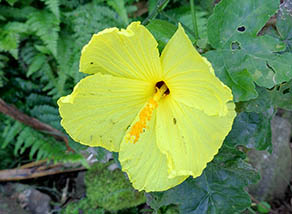
“Native plants sprout up in the shade, they really take their time: they establish a nice root base and then they eventually start to fill in the canopy. So we moved the whole site back to where we’re working now, to the ten acres where we are now. Which is a lot of kukui and mountain apple trees—Polynesian introductions—and it’s a really, really nice site. We use those trees as sort of nursery trees to keep all the weeds back. We plant native trees and they’ll grow and turn into a forest canopy but then the understory is kind of this mess. “The upper valley way, way back out is a hanging valley. It’s three thousand foot cliffs on all sides. So it’s pretty much pristine native forests back there. ‘Pretty much,’ because we are managing it heavily. There are a lot of invasive plants that are moving in that we are controlling up there. But the upper preserve is four hundred acres and it’s surrounded entirely by an ungulate-proof fence that was put up in 2010, I believe. “They have an extremely important habitat for endangered, nesting sea birds. There is the Hawaiian petrol and ua‘u, and noodle sheerwater—the a‘e. Most of the work we do up there is actually funded to protect the habitat of those birds. We do a predator control program, and then a lot of the weed work programs that I run are funded to protect the nesting sites of those birds.” Read about endangered birds at Hā‘ena. “Now we have invasive bird species, dispersing invasive plant species,” Kawika says, “which is frustrating. One of the worst ones is the Japanese White Eye. It’s called a mejido. It’s bad on two levels. Because it has different size of its mouth and its throat and things like that, it disperses a certain range of seeds that are a lot of the worst invasives we have, like the Himalayan Ginger. “Then we have these lobelia complex, so it’s the lobelias—the Trematolobelia, the Cyanea, those kind of things—those are the ones with the curved flowers that would match the curved beaks of the honeycreepers. So even in areas where are still these lobelia plants and they still have these honey creepers, they’re trying to get to them, but the white eyes are nectar robbers. They’ll peck a hole at the bottom of the curved flower and steel the nectar without even pollinating the plant. And so the honey creeper comes along, tries to find the nectar, and they would usually pollinate the plant in the process. But there is no nectar, so the bird flies away hungry. It’s just really frustrating, it’s very frustrating, that particular part of the story. But there are a lot of successful things I like to focus on.”
|
 |
||
 |
Inasmuch as human intervention has brought invasive species to the islands, so too has it produced new problems in regard to healthy food.
|
 |
||
 |
|
 |
||

|
|
||||
| Copyright 2018 Pacific Worlds & Associates • Usage Policy • Webmaster |
||||

